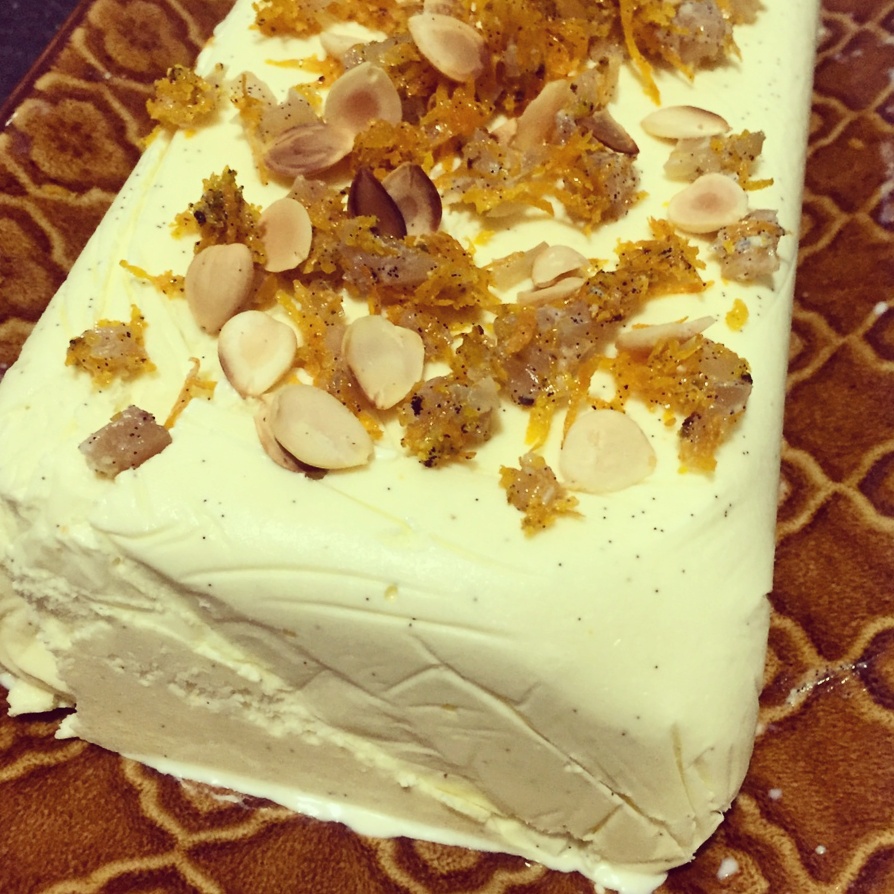Homemade ice cream! Ice cream. Homemade. Without an ice cream churning machine. Talk about bragging rights. Yes, it is a time-consuming affair, especially if you do not have an ice cream machine, but to us, the plus outweighs such factors as lack of sleep (If you are like Darsh anyway, who prefers to make ice cream at night when the kitchen is generally cooler).
After all, you will know exactly what goes into your ice cream, so you’ll know there isn’t any preservatives or artificial flavouring in every luscious creamy scoop, you can experiment with flavours, and you can make it days ahead.
Now while an ice cream terrine sounds fancy, it’s so simple to put together. Less effort, in fact, than scooping ice cream into individual bowls, AND you get to appreciate the ooos and ahhs when you unveil your amazing dessert to your guests, #somuchwin. So this is exactly what we decided to serve up for a dinner party. But instead of the usual, although no less delicious, chocolate or vanilla options, we decided to take it up a notch by using the amazingly-perfumed orange blossom water.
For the basic custard-based ice cream, we’ve taken this vanilla recipe by David Lebovitz and adjusted the flavour. And if, like us, you are without an ice cream machine, you can follow Lebovitz’s instructions on how to do without, which basically calls for you to break up the ice crystals every half hour.
Ingredients
- 1 cup almond slivers, roasted
- For ice cream
- 3 tbsp orange blossom water
- 1 tbsp candied ginger, chopped
- Zest of two large oranges
- 1 cup whole milk
- 3/4 cup sugar
- 1 vanilla stick
- 2 cups heavy or double cream, chilled
- 5 large egg yolks
- Pinch of salt
Instructions
- Heat the milk, salt and sugar in a saucepan. Stir until the sugar has melted.
- Add the orange zest, orange blossom water, chopped candied ginger as well as seeds and leftover vanilla stick into the milk. Remove milk from heat, and set aside for an hour.
- In another bowl, beat the egg yolks until light, thick and fluffy, about 7 to 8 minutes.
- Remove the vanilla stick and strain the milk. Keep the orange zest and ginger for later.
- Reheat the milk. Taking care it is not too hot, pour some of the milk mixture into the yolks, whisking as you do so.
- Pour the egg-milk mixture back into the pot with the remaining milk, and cook the mixture over low heat until you get a thick, smooth custard that coats the back of a spoon.
- Meanwhile, pour the cream into a chilled bowl and place that bowl over an ice bath. Make sure you use a freezer-safe mixing bowl, such as stainless steel.
- Strain the custard into the cream and whisk the mixture until it is completely chilled. Place in freezer.
- After 45 minutes, check on the ice cream. It should have formed crystals around the edges. Beat up the mixture using a whisk, spatula or hand-held blender, ensuring there are no lumps or crystals left. Return mixture to freezer.
- Repeat this process every half hour, five or six times (about 2 to 3 hours). You will find the mixture becomes harder and harder each time as it freezes, but persist! When you beat up the mixture for the last time, pour the ice cream into a bread pan lined with cling wrap [Make sure there is a generous amount of cling wrap hanging over the sides]. Freeze until ready to serve.
- Remove bread pan from freezer and place in the fridge some 5 to 10 minutes before you wish to serve. If need be, run some water over the base of the pan to loosen the ice cream and turn it out onto a long serving platter.
- Remove cling wrap and top the terrine with the preserved orange zest and candied ginger, as well as roasted almonds. Cut into slices to serve.
Curdled the custard?!?!
The milk was probably too hot. In any case, don’t panic. You don’t have to start all over again providing the custard isn’t too badly curdled. If you find that the mixture is slightly grainy, you can just place the base of the custard bowl in an ice bath to stop it from curdling further, then strain the lumps out. If it is slightly more lumpy, place the mixture in a blender or food processor and blend until smooth. Then, when you add the custard to the cream, strain the mixture yet again to ensure a smoother, creamier end result.


Rate this recipe
1 People Rated This Recipe
Average Rating
No comments yet.